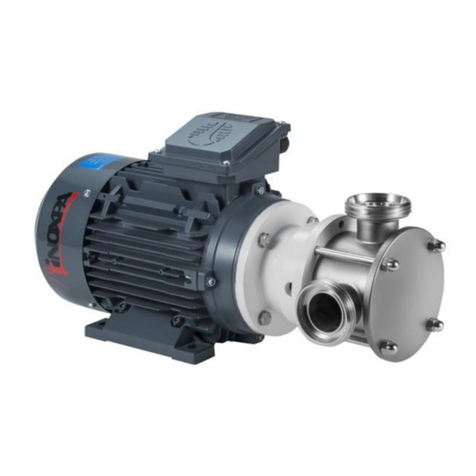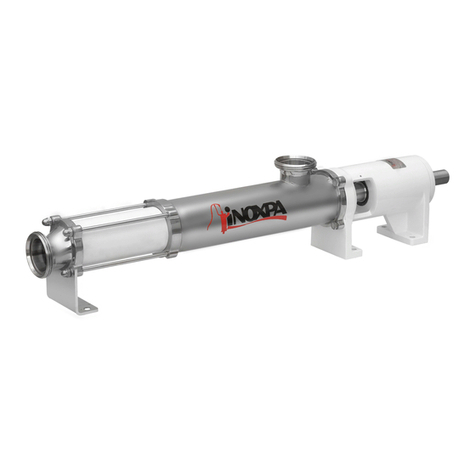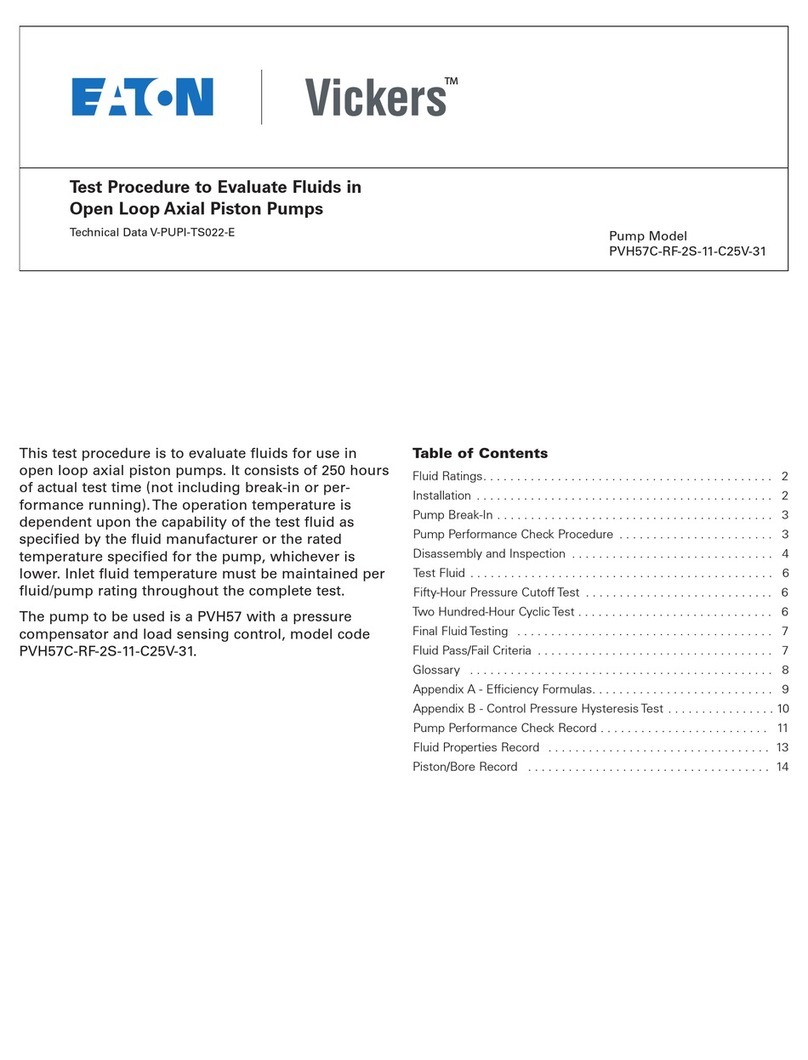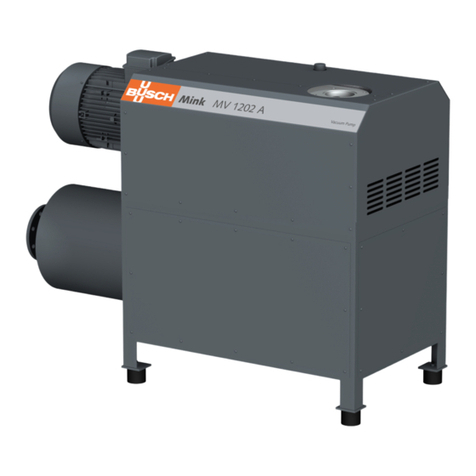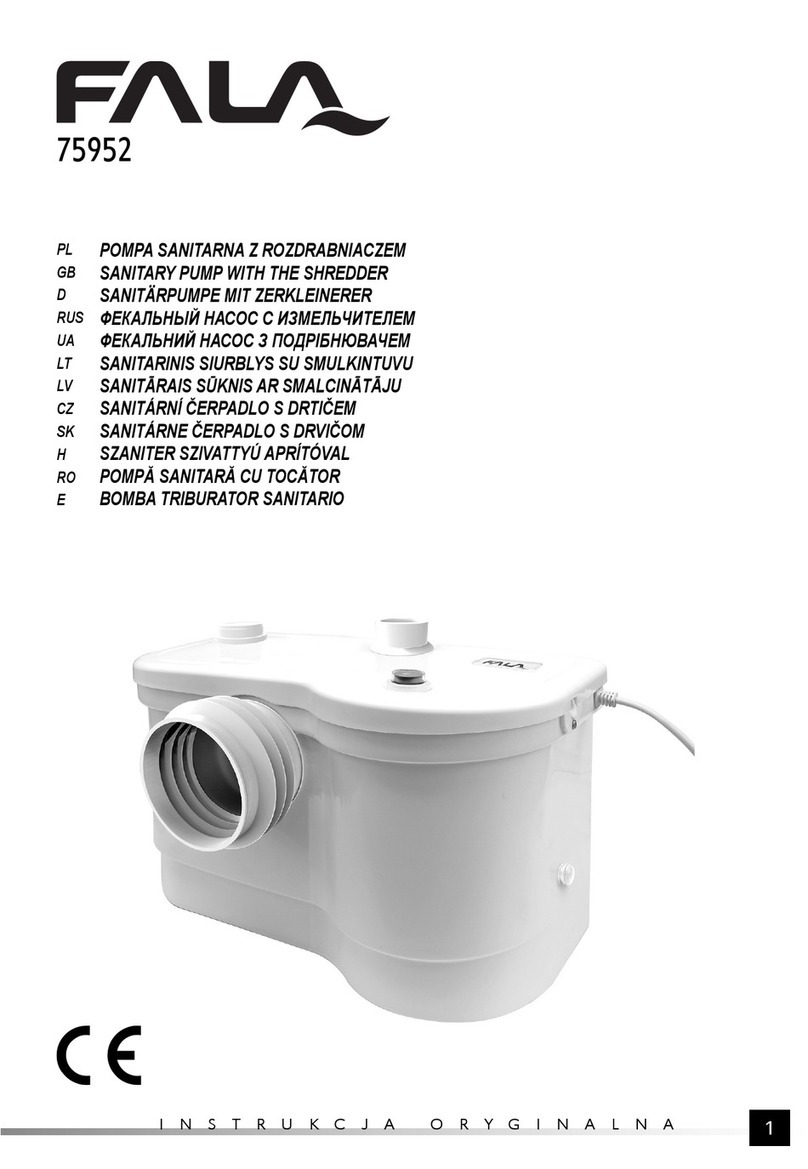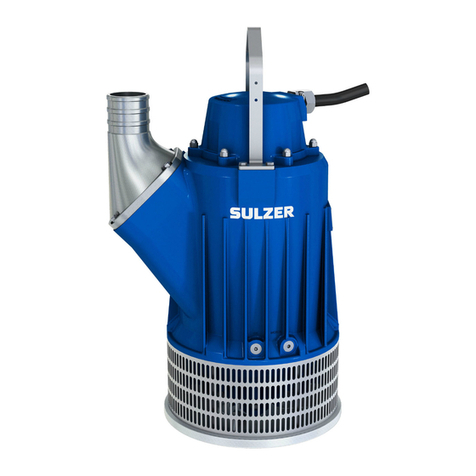INOXPA RV Manual

CENTRIFUGAL PUMP WITH HELICOIDAL
IMPELLER
RV
Original Instructions
01.214.30.03EN
(0) 2021/04
INSTALLATION, SERVICE AND MAINTENANCE INSTRUCTIONS
01.214.32.0013

E C D e c l a r a t i o n o f C o n f o r m i t y
Model:
INOXPA S.A.U.
Telers, 60
17820 - Banyoles (España)
hereby declare under our sole responsibility that the
Type:
Serial number:
RV
RV-65, RV-80, RV-100
IXXXXXX to IXXXXXX1
fullls all the relevant provisions of the following directive:
Machinery Directive 2006/42/EC
Regulation (EC) nº 1935/2004
The technical le has been prepared by the signer of this document.
Technical Oce Manager
15 de febrero de 2021
01.214.30.04EN
(0) 2021/02
Document:
Revision:
Machine: CENTRIFUGAL PUMP WITH HELICOIDAL IMPELLER
and with the following harmonized standards and/or regulations:
David Reyero Brunet
EN ISO 12100:2010
EN 809:1998+A1:2009/AC:2010
EN 60204-1:2006+A1:2009
A copy of the technical le is in the possession of the notied body L.C.I.E. with reference
number 0081
1) the serial number may be preceded by a slash and by one or two alphanumeric characters
XXXXXXXXXIIN to XXXXXXXXXIIN1

1. Table of Contents
1. Table of contents
2. Generalities
2.1. Instructions manual.................................................................................................................................4
2.2. Compliance with the instructions ............................................................................................................4
2.3. Warranty..................................................................................................................................................4
3. Safety
3.1. Warning symbols.....................................................................................................................................5
3.2. General safety instructions .....................................................................................................................5
4. General Information
4.1. Description ..............................................................................................................................................7
4.2.Application...............................................................................................................................................7
5. Installation
5.1. Reception of the pump............................................................................................................................8
5.2. Identication of the pump........................................................................................................................8
5.3.Transport and storage............................................................................................................................. 9
5.4. Location ..................................................................................................................................................9
5.5. Pipes .....................................................................................................................................................10
5.6. Electrical installation .............................................................................................................................10
6. Start-up
6.1. Checks before starting the pump .......................................................................................................... 11
6.2. Checks when starting the pump............................................................................................................ 11
7. Troubleshooting
8. Maintenance
8.1. General considerations .........................................................................................................................14
8.2. Check the mechanical seal ...................................................................................................................14
8.3. Maintenance of the seals ......................................................................................................................14
8.4.Tightening torque .................................................................................................................................. 14
8.5. Storage .................................................................................................................................................15
8.6. Cleaning................................................................................................................................................15
8.7. Disassembly and assembly of the pump ..............................................................................................16
9. Technical Specications
9.1. Weights .................................................................................................................................................18
9.2. Dimensions ...........................................................................................................................................18
9.3. Exploded drawing .................................................................................................................................19
9.4.Technical section and parts list ............................................................................................................. 20
INOXPA S.A.U. 01.214.30.03EN · (0) 2021/04 3

2. Generalities
2.1. INSTRUCTIONS MANUAL
This manual contains information about the reception, installation, operation, assembly and mainte-
nance of the RV pumps.
v
Carefully read the instruction before starting the pump, familiarize yourself with the installation,
operation and correct use of the pump and strictly follow the instructions. These instructions should
be kept in a safe location near the installation area.
The information published in the instruction manual is based on updated data.
INOXPA reserves the right to modify this instruction manual without prior notice.
2.2. COMPLIANCE WITH THE INSTRUCTIONS
Not following the instructions may impose a risk for the operators, the environment and the machine,
and may cause the loss of the right to claim damages.
This non-compliance may cause the following risks:
- failure of important machine/plant functions,
- failure of specic maintenance and repair procedures,
- possible electrical, mechanical and chemical hazards,
- the risk to the environment due to the type of substances released.
2.3. WARRANTY
The conditions of the warranty are specied in the General Sales Condition that have been delivered
at the time of placing your order.
The machine may not undergo any modication without prior approval from the manu-
facturer.
For your safety, only use original spare parts and accessories. The usage of other parts
will relieve the manufacturer of any liability.
Changing the service conditions can only be carried out with prior written authorization
from INOXPA.
Please do not hesitate to contact us in case of doubts or if further explanations are required regar-
ding specic data (adjustments, assembly, disassembly, etc.).
The non-compliance of the prescribed indications in this manual means misuse of this gear on
the technical side and the personal safety and this, exempt INOXPA of all responsibility in case
of accidents and personal injuries and/or property damage. Also, excluded from the warranty all
breakdowns caused by improper use of the gear.
Generalidades
INOXPA S.A.U. 01.214.30.03EN · (0) 2021/04
4

3.1. WARNING SYMBOLS
3. Safety
Safety hazard for people in general and/or for the equipment
ATTENTION Important instruction to prevent damage to the equipment and/or its function
3.2. GENERAL SAFETY INSTRUCTIONS
Read the instruction manual carefully before installing and starting the pump. Contact
INOXPA in case of doubt.
3.2.1. During installation
Always take into account the Technical Specications of chapter 9.
Never start the pump before connecting it to the lines.
Do not operate the pump if the pump casing is not tted.
Check for proper specications of the motors, especially if working conditions create an
explosions hazard.
3.2.2. During operation
The Technical Specications of chapter 9 should always be observed. Under no
circumstances can the specied limit values be exceeded.
NEVER touch the pump or the pipework during operation if the pump is being used for
transferring hot liquids or during cleaning.
The pump contains moving parts. Never place your ngers inside the pump during ope-
ration.
NEVER operate with the suction and discharge valves closed.
NEVER spray water directly on the electrical motor. The standard motor protection is
IP55: protection against dust and water spray.
Electric hazard
During the installation, all the electric work should be carried out by authorized personnel.
Seguridad
5
INOXPA S.A.U. 01.214.30.03EN · (0) 2021/04

3.2.3. During maintenance
The Technical Specications of chapter 9 shall always be observed.
NEVER disassemble the pump until the pipes have been emptied. Remember that liquid
will remain inside the pump’s pump casing (if does not have a purge). Bear in mind that
the pumped liquid may be hazardous or extremely hot. Consult the regulations in eect
in each country for these cases.
Do not leave loose parts on the oor.
ALWAYS disconnect the electrical power to the pumps prior to carrying out any mainte-
nance.
Remove the fuses and disconnect the cable from the motor’s terminals.
All electrical work must be carried out by authorized personnel.
Seguridad
INOXPA S.A.U. 01.214.30.03EN · (0) 2021/04
6

4. General Information
4.1. DESCRIPTION
4.2. APPLICATION
The centrifugal pumps with helicoidal impeller RV are monobloc pumps with axial suction and radial
discharge and sanitary connections. The RV range is designed for continuous operation.
The main components of the RV pump are a pump casing with drainage, a helicoidal impeller and
a single mechanical seal in silicon carbide with EPDM seals.
All parts of the RV pump are in contact with the product are stainless steel 1.4404 (AISI 316L). The
internal surface of the pump can be polished or matt and the external surface is always matt. The
motor is standard IEC 60034 type IM B35.
The centrifugal pumps with helicoidal impeller RV are the best solution for the transfer of liquids with
a high concentration of solid particles. These liquids need be pumped gently and without clogging
and this is achieved with an helicoidal design of the impeller.
It is ideal for applications of the transfer of pieces of fruit or whole fruits, olives, mushrooms, vege-
tables, sh or any product which require the preservation of the form of the solids in suspension.
It is also suitable in the wine industry for the pump-over process where the high capacity and mini-
mum destruction of the solid parts (seeds, skins, etc.) is required.
The range of application for each type of pump is limited. The pump was selected for a
given set of pumping conditions when the order was placed. Misuse of the pump or its
use beyond the operating limits may be dangerous or cause permanent damage to the
equipment. INOXPA shall not be liable for any damage resulting from the incompleteness
of the information provided by the purchaser (nature of the uid, rpm, etc.).
ATTENTION
Información General
7
INOXPA S.A.U. 01.214.30.03EN · (0) 2021/04

5.1. RECEPTION OF THE PUMP
5. Installation
The pump package includes the following documents:
- shipping documents,
- installation, service and maintenance instructions manual,
- instructions and service manual of the motor1
1) if the pump has been supplie with a motor from INOXPA
INOXPA cannot be held responsible for the damage sustained by the equipment during
transport or unpacking. Please visually check that the packaging is not damaged.
Unpack the pump and check the following:
- the suction and discharge connections of the pump, removing any rest of packaging materials,
- the pump and the motor are not damaged,
If the equipment is not in good condition and/or any part is missing, the carrier should report accor-
dingly as soon as possible.
5.2. IDENTIFICATION OF THE PUMP
Each pump has a nameplate with the basic data required to identify the model.
C. TELERS, 60 - 17820 BANYOLES
GIRONA (SPAIN) . www.inoxpa.com
INOXPA S.A.U.
Type
Year
No
R
Serial number
01.214.32.0015
Instalación
INOXPA S.A.U. 01.214.30.03EN · (0) 2021/04
8

5.3. TRANSPORT AND STORAGE
The RV pumps are often too heavy to be stored manually.
Use an appropriate means of transport.
Use the points which are indicated in the drawing for lifting the pump.
Only authorized personnel should transport the pump.
Do not work or walk under the heavy loads.
Lift the pump as indicated below:
- always use two support points placed as far apart as possible.
- secure the supports so that they will not move.
See chapter 9. Technical Specications to consult the dimensions and weight of the pump.
During the transport, disassembly or assembly of the pump, there is a risk of loss of
stability and that the pump could fall down and cause damages to the operators. Make
sure that the pump is properly supported.
5.4. LOCATION
Place the pump as close as possible to the suction tank whenever possible below the liquid and lea-
ving enough space around to can access the pump and the motor. If necessary, consult in chapter
9. Technical Specications the dimensions of the pump.
Once a place is chosen, the pump should be mounted on a at and level surface.
Install the pump so as to allow proper ventilation.
If the pump is installed outdoors, it should be covered by a roof. Its location should allow
easy access for inspection or maintenance operations.
5.4.1. Excessive temperatures
Depending on the uid to be pumped, high temperatures can be reached inside and around the
pump.
ATTENTION
ATTENTION
ATTENTION
01.214.32.0016
Instalación
9
INOXPA S.A.U. 01.214.30.03EN · (0) 2021/04

Over 68ºC the operator should take protective measures and place warning notices
advising of the danger which exists if the pump is touched.
The type of protection selected should not isolate the pump entirely. It should allow for
the bearings to be cooled more eciently and for the bearings to be lubricated.
5.5. PIPES
About the installation pipes:
- As a general rule, install the suction and discharge lines in straight sections, with the minimum
possible number of elbows and ttings to reduce any pressure losses that may be caused by
friction.
- Make sure that the pump’s ports are properly aligned with the pipework and have a diameter
similar to that of the pump connections.
- Place the pump as close as possible to the suction tank and whenever possible below the
liquid level, or even below the tank level in order to achieve the largest possible static head
for suction.
- Install support brackets for the lines as close as possible to the pump’s suction and discharge
ports to avoid vibrations and stress on the pump.
5.5.1. Shut-o valves
The pump may be isolated for maintenance. To accomplish this, shut-o valves must be installed
and connected to the pump’s suction and discharge connections.
5.6. ELECTRICAL INSTALLATION
Only qualied personnel can connect the electric motors.
Take the necessary measures to prevent damage to cables and connections.
Electrical equipment, terminals and components of the control systems may still carry
current when they are disconnected. Contacting them may impose a hazard to operators
or cause irreparable material damage.
Before handling the pump, make sure that the motor is stopped.
To do the electrical installation:
- connect the motor in accordance with the instructions supplied by the motor manufacturer, in
accordance with the current national legislation and in compliance with EN 60204-1,
- check the direction of rotation (see the signalling label on the pump),
- start and stop the pump motor momentarily. Make sure that the direction of rotation is correct.
If the pump rotates in the wrong direction it could cause serious damage.
ATTENTION
See indicator label on the pump.
ALWAYS check the direction of rotation of the motor with liquid inside the pump.
01.214.32.0017
Instalación
INOXPA S.A.U. 01.214.30.03EN · (0) 2021/04
10

Before starting the pump:
- completely open the shut-o valves on the suction and discharge lines,
- if liquid does not ow towards the pump, ll it with the liquid to be pumped,
6. Start-up
6.1. CHECKS BEFORE STARTING THE PUMP
Before starting the pump, carefully read the instructions in section 5. Installation.
Carefully read section 9. Technical Specications. INOXPA will not be liable for impro-
per use of the equipment.
NEVER touch the pump or the lines of hot liquids are being pumped.
The pump must never turn dry.
- check that the power supply matches the rating indicated on the motor plate,
- check that the motor rotation direction is correct.
6.2. CHECKS WHEN STARTING THE PUMP
When starting the pump check:
- that the pump is not making any strange noises,
- if the absolute inlet pressure is sucient to prevent cavitation in the pump. See the curve to
determine the minimum pressure required above steam pressure (NPSHr).
- the discharge pressure,
- that there are no leaks in the sealing areas.
Shut-o valves on the suction pipe must not be used to regulate the ow. All shut-o
valves must be fully open during operation.
ATTENTION
Control the motor consumption to prevent an electrical overload.
To reduce the ow rate and the electrical power consumed by
the motor:
- reduce regulating the pump’s discharge ow,
- decrease the motor speed.
ATTENTION
ATTENTION
01.214.32.0018
Puesta en marcha
11
INOXPA S.A.U. 01.214.30.03EN · (0) 2021/04

Use special protection when the sound pressure in the operation area exceeds 85
dB(A).
Puesta en marcha
INOXPA S.A.U. 01.214.30.03EN · (0) 2021/04
12

7. Troubleshooting
Motor overload
The pump does not provide enough ow or pressure
No pressure on the discharge side
Uneven delivery ow / pressure
Noise and vibrations
The pump gets clogged
Overheated pump
Excessive wear
The mechanial seal leaks
PROBABLE CAUSES SOLUTIONS
• • Wrong direction of rotation - Reverse the direction of rotation
• • • • NPSH is not high enough
- Place the suction tank higher
- Place the pump lower
- Increase the diameter of the suction pipe
- Shorten and simplify the suction pipe
• Pump not drained - Drain or ll
• • • • Cavitation - Increase the suction pressure
• • • • Air is sucked in by the pump - Check the suction pipe and all its
connections
• • • Clogged suction tube - Check the suction pipe
• • Discharge pressure too high - If necessary, reduce load losses, e.g. by
increasing the diameter of the pipe.
• • • Flow too high
- Reduce the ow by means of a diaphragm
- Partially shut o the delivery valve
- Reduce speed
• • • • • • Fluid viscosity too high - Decrease the viscosity by injecting liquid
or increasing the diameter of the piping
• • • • • Fluid temperature too high - Reduce the temperature by cooling the
uid
• Mechanical seal damaged or worn - Replace the seal
•O-rings unsuitable for the uid - Fit suitable O-rings after checking with
the supplier
• • • • The impeller scrapes - Reduce temperature
- Reduce suction pressure
• Tension in the lines - Connect the pipes to the pump without
tension
• Pump speed too low - Increase speed
•The cut-o valve on the suction side is
closed
- Check and open
• Discharge pressure too low - Increase the pump speed
The following table provides solutions to problems that might arise during the operation of the pump.
The pump is assumed to have been properly installed and be suitable for the relevant application.
Please contact INOXPA if technical assistance is required.
Incidentes de funcionamiento
13
INOXPA S.A.U. 01.214.30.03EN · (0) 2021/04

8. Maintenance
8.1. GENERAL CONSIDERATIONS
8.2. CHECK THE MECHANICAL SEAL
8.3. MAINTENANCE OF THE SEALS
SEALS REPLACEMENT
Preventive maintenance Replace after twelve (12) months. We also recommend re-
placing the gaskets during seal or pump shaft replacement.
Maintenance after a leak Replace at the end of the process
Scheduled maintenance
Regularly check that there are no leaks and that the pump is
operating correctly.
Keep a maintenance record of the pump.
Use statistics to plan inspections.
Lubrication
During assembly, use soapy water or oil compatible for the
food industry when tting the dierent gaskets to allow them
to slide better.
This pump, just like any other machine, requires maintenance. The instructions contained in this
manual cover the identication and replacement of spare parts. The instructions are aimed at
maintenance personnel and those responsible for the supply of spare parts.
Carefully read chapter 9. Technical Specications.
Maintenance work can only be carried out by qualied personnel that are trained and
equipped with the necessary resources to carry out this work.
All parts or materials that are replaced must be properly disposed of/recycled in
accordance with the current directives applicable in each area.
ALWAYS disconnect the pump before beginning any maintenance work.
Periodically check that there are no leaks around the shaft. If leakage is detected through the
mechanical seal, replace it following the instructions in chapter 8.7. Disassembly and assembly of
the pump.
The period between each preventive maintenance service will vary depending on the operating
condition of the pump: temperatures, ow, number of operating hours, cleaning solutions used, etc.
8.4. TIGHTENING TORQUE
Size Nm lbf·ft
M6 10 7
M8 21 16
M10 42 31
M12 74 55
M16 112 83
Mantenimiento
INOXPA S.A.U. 01.214.30.03EN · (0) 2021/04
14

8.5. STORAGE
Before being stored the pump must be completely emptied of liquids. Avoid, as far as possible, the
exposure of the parts to excessively damp atmospheres.
8.6. CLEANING
The use of aggressive cleaning products such as caustic soda and nitric acid may give
raise to skin burns.
Use rubber gloves during cleaning procedures.
Always use protective goggles.
8.6.1. Automatic CIP (clean-in-place)
If the pump is installed in a system with a CIP process, it is not necessary to disassemble the pump.
If the automatic cleaning process is not provided, proceed to disassemble the pump as indicated in
the chapter 8.7. Disassembly and assembly of the pump.
ATTENTION
Check the concentration of the cleaning solutions. Incorrect concentrations may lead to
the deterioration of the pump seals.
To remove any traces of cleaning products ALWAYS perform a nal rinse with clean water at the end
of the cleaning process.
Two types of solutions can be used for CIP processes:
a. alkaline solution: 1% by weight of caustic soda (NaOH) a 70ºC (150ºF). To make this solution:
1 kg NaOH + 100 l H2O1= cleaning solution
2,2 l NaOH 33% + 100 l H2O = cleaning solution
b. acid solution: 0,5% by weight of nitric acid (HNO3) a 70ºC (150ºF). To make this solution:
0,7 l HNO3 53% + 100 l H2O = cleaning solution
1) only use chlorine-free water to mix with the cleaning agents
Mantenimiento
15
INOXPA S.A.U. 01.214.30.03EN · (0) 2021/04

Disassembly:
1. Loosen the retention ring nut (15) and remove it.
2. Remove the pump casing (01) and the O-ring (80).
3. Loosen the impeller (02) allen screw (51) and remove both.
Assembly:
1. Place the O-ring (80).
2. Place the impeller (02) and x it with the allen screw (51).
3. Mount the pump casing (01) with the retention ring (15).
4. Tighten the retention ring (15) nut.
8.7. DISASSEMBLY AND ASSEMBLY OF THE PUMP
The assembly and disassembly of the pumps should be done by qualied personnel. Make sure that
the personnel read carefully this instruction manual and, in particular, those instructions which refer
to the work they will perform.
ATTENTION
Incorrect assembly or disassembly may cause damage in the pump’s operation and lead
to high repair costs and a long period of downtime.
INOXPA is not responsible for accidents or damages cause by a failure to comply with
the instructions in this manual.
Preparation
Provide for a clean working environment so some parts, including the mechanical seal, require very
careful handling and others have close tolerances.
Check that the parts which are used are not damaged during transport. When doing this, you need
to inspect the adjustment edge, the butted faces, the tight t, burrs, etc.
After each disassembly, carefully clean the parts and check for any damage. Replace all damaged
parts.
Tools
Use the proper tools for assembly and disassembly operations. Use them correctly.
Cleaning
Before disassembling the pump, clean it outside and inside.
01.214.32.0019
8.7.1. Pump casing and impeller
Mantenimiento
INOXPA S.A.U. 01.214.30.03EN · (0) 2021/04
16

7. Place the key (61) and continue with the assembly of the pump casing and impeller according
to chapter 8.7.1. Pump casing and impeller.
8.7.2. Lantern and mechanical seal
Disassembly:
1. Remove the key (61) and extract the
rotary part of the mechanical seal
(08).
2. Loosen the 4 hexagonal screws (52)
and remove them and their grower
washers (53).
3. Remove the lantern (04), the
stationary part of the mechanical seal
(08) that is housing inside the lantern
and the splash ring (82).
4. Loosen the allen screws (51A) and
remove the shaft.
Assembly:
1. Place the shaft and x it with the allen screws (51A) according to the tightening torque value
indicated in chapter 8.4. Tightening torque.
2. Slide the splash ring (82) over the pump shaft (05) without pushing it to the end.
3. Mount the lantern (04) and x it with the hexagonal screws (52) and their grower washers (53).
4. Place the stationary part of the mechanical seal (08) in the lantern (04) taking into account the
position of the impeller knob.
5. Mount the rotary part of the mechanical seal (08) by entering the seal through the pump shaft
(05).
6. Check that the assembly dimension “A” of the following gure like the same detailed in the next
table.
Pump Seal A
RV-65 Ø25 40,5±0,5
RV-80 Ø30 42,5±0,5
RV-100
01.214.32.0020
01.214.32.0021
Mantenimiento
17
INOXPA S.A.U. 01.214.30.03EN · (0) 2021/04

9. Technical Specications
9.1. WEIGHTS
Maximum ow rate 180 m3/h
Maximum dierential head 22 m
Maximum working pressure 1000 kPa (10 bar)
Operating temperature range -10ºC a 120ºC (EPDM)
Maximum speed 1800 rpm
Sound level 60-80 dB(A)
Suction/discharge connections DIN 11851
Materials
Parts in contact with the product 1.4404 (AISI 316L)
Other parts in stainless steel 1.4301 (AISI 304)
Seals in contact with the product EPDM - standard
Other materials for the seal consult with INOXPA
Internal surface nish polished or matt
External surface nis matt
Mechanical seal
Type single mechanical seal
Material of stationary part silicon carbide (SiC)
Material of rotary part silicon carbide (SiC)
Seal material EPDM
Motor
Type Three-phase asynchronous motor, IEC B35 type,
4 poles, IP55 protection, class F-insulation
Power 0,75 - 4 kW
Speed 1500 rpm
Voltage and frequency 220-240 VΔ / 380-420 V Y, ≤4 kW
380-420 VΔ / 660-690 V Y,≥ 5,5 kW
Pump Weight (kg)
RV-65 26
RV-80 49
RV-100 67
9.2. DIMENSIONS
01.214.32.0024
Pump A B C
RV-65 120 250 345
RV-80 170 320 410
RV-100 190 345 470
Especicaciones Técnicas
INOXPA S.A.U. 01.214.30.03EN · (0) 2021/04
18

9.3. EXPLODED DRAWING
01.214.32.0022
Especicaciones Técnicas
19
INOXPA S.A.U. 01.214.30.03EN · (0) 2021/04

9.4. TECHNICAL SECTION AND PARTS LIST
Position Description Quantity Material
01 pump housing 1 1.4404 (AISI 316L)
02 helical impeller 1 1.4404 (AISI 316L)
04 lantern 1 1.4404 (AISI 316L)
05 shaft 1 1.4404 (AISI 316L)
08 mechanical seal11 Si/Si/EPDM
15 retention ring 1 1.4301 (AISI 304)
47 protection 2 methacrylate
50 hexagonal screw 4 A2
51 allen screw 1 A4
51A allen screw 2 A2
52 hexagonal screw 4 A2
53 grower washer 4 A2
53A at washer 4 A2
61 key 1 1.4404 (AISI 316L)
80 O-ring11 EPDM
81A gasket11 PTFE
82 splash ring 1 NBR
87 drain plug 1 -
93 motor 1 -
1) recommended spare parts
01.214.32.0024
Especicaciones Técnicas
INOXPA S.A.U. 01.214.30.03EN · (0) 2021/04
20
This manual suits for next models
3
Table of contents
Other INOXPA Water Pump manuals

INOXPA
INOXPA PROLAC HCP Ex Manual

INOXPA
INOXPA HYGINOX SE Series Manual

INOXPA
INOXPA KIBER KSF Series Installation and user guide
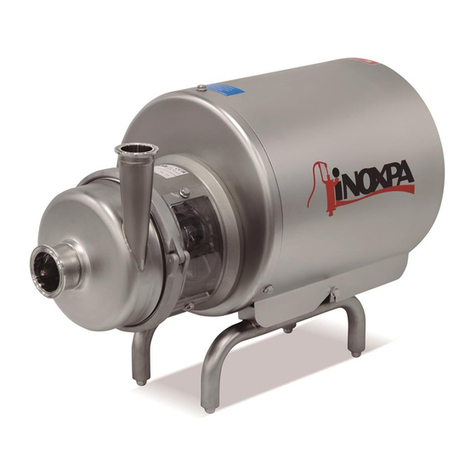
INOXPA
INOXPA PROLAC HCP Series Manual

INOXPA
INOXPA HLR Ex Manual
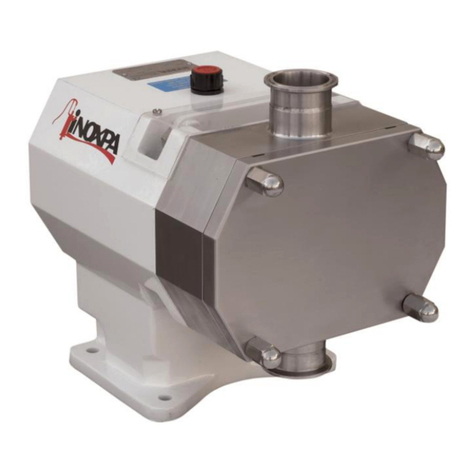
INOXPA
INOXPA HLR Manual

INOXPA
INOXPA PROLAC HCP Ex Manual
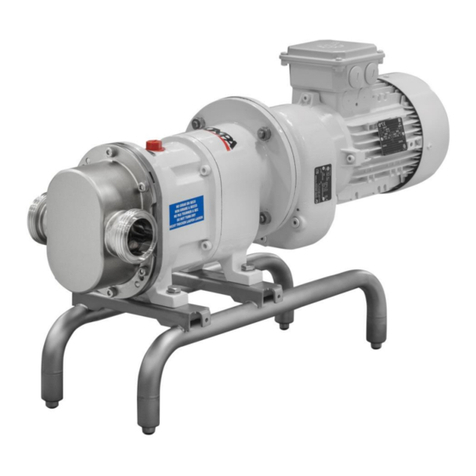
INOXPA
INOXPA TLS Series Manual

INOXPA
INOXPA KIBER KS Series Manual

INOXPA
INOXPA KIBER KTE Manual
Popular Water Pump manuals by other brands
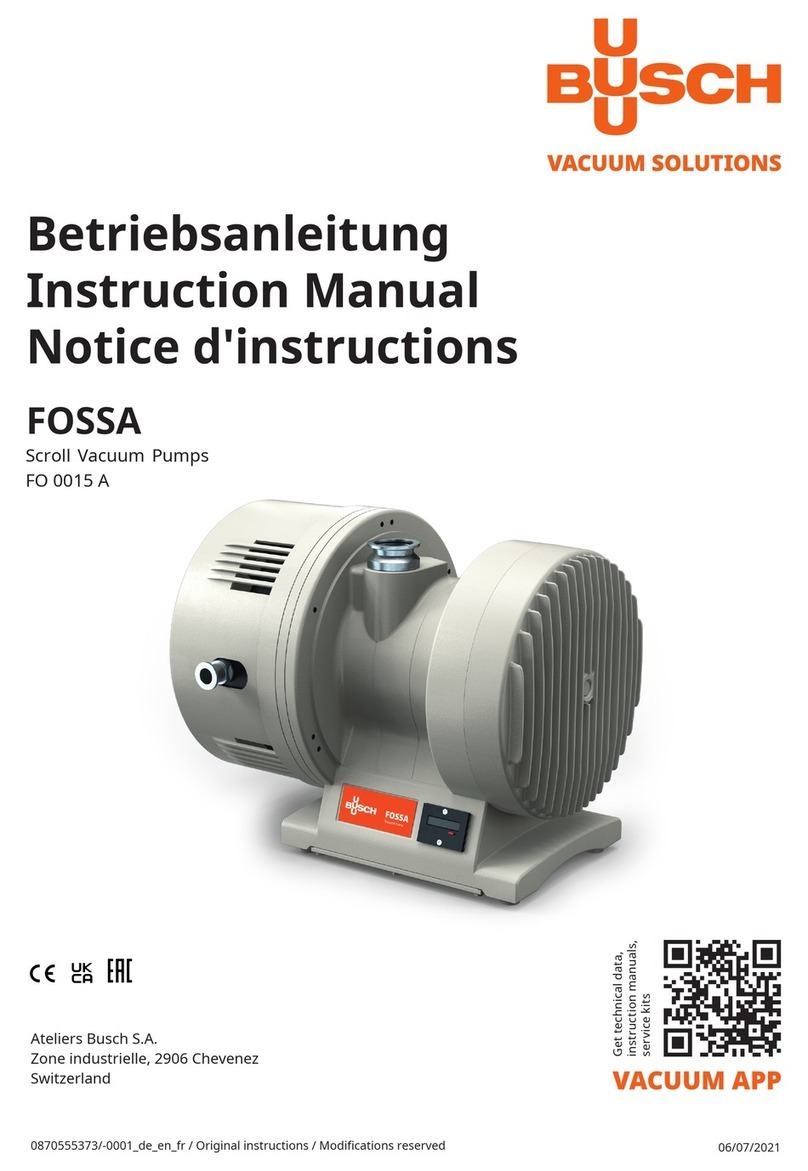
BUSCH
BUSCH Fossa FO 0015 A instruction manual
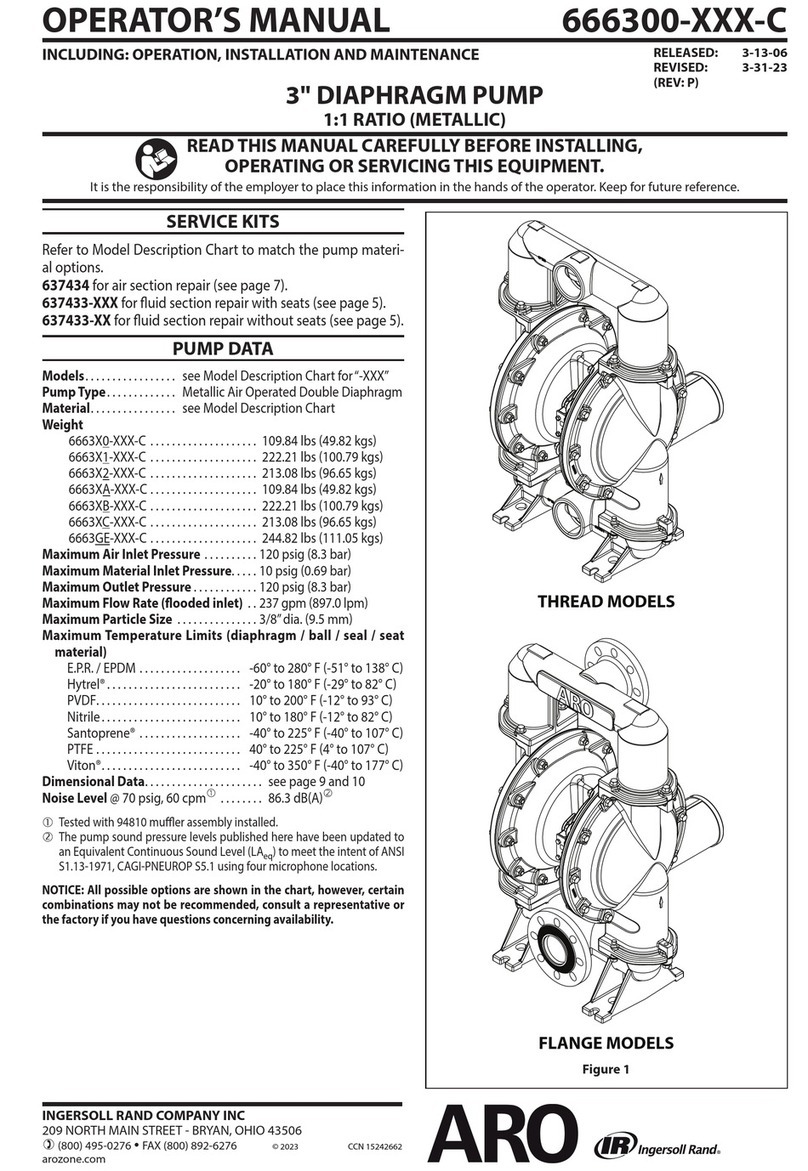
Ingersoll-Rand
Ingersoll-Rand ARO 666300 C Series Operator's manual

GORMAN-RUPP
GORMAN-RUPP AMT 576D-95 manual

Milton Roy
Milton Roy MILROYAL B instruction manual
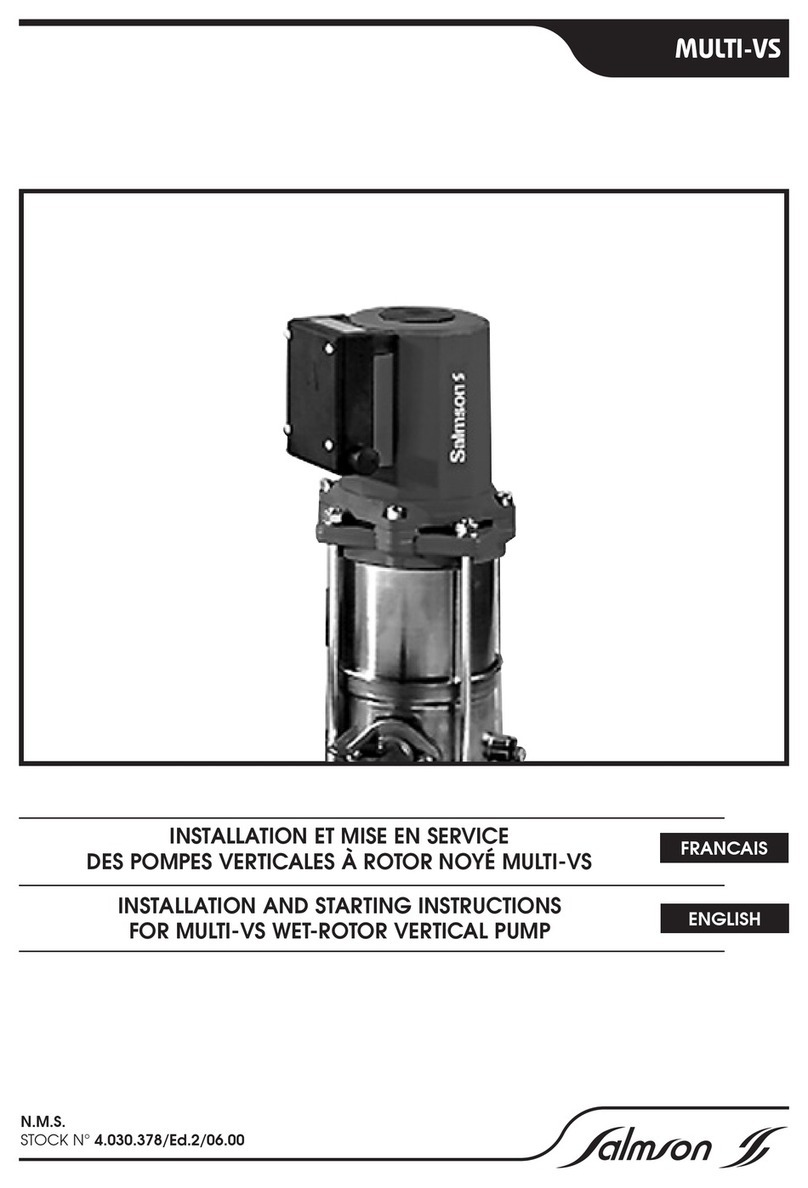
salmson
salmson MULTI-VS Installation and starting instructions

Pentair
Pentair Flotec SUB 3S Use and maintenance manual




